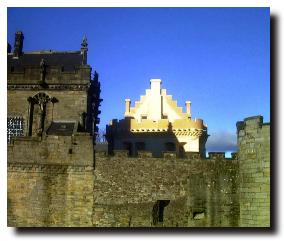 The writer Alexander Smith was accurate when he said "Stirling, like a huge brooch, clasps Highlands and Lowlands together." It was natural that the lowest crossing place of the river Forth, which was also reachable by boat from the sea and with a natural volcanic outcrop on which to build a fortification, should be the place where the monarch would construct a royal castle.
The writer Alexander Smith was accurate when he said "Stirling, like a huge brooch, clasps Highlands and Lowlands together." It was natural that the lowest crossing place of the river Forth, which was also reachable by boat from the sea and with a natural volcanic outcrop on which to build a fortification, should be the place where the monarch would construct a royal castle.
There may have been earlier forts but it was King Alexander I in early 12th century who built a chapel there and he probably died at Stirling in 1124. Later, Stirling was one of five Scottish castles passed over to Henry II of England in payment for the release of William the Lion. Although it was later returned to Scotland, King Edward I took over all the Scottish royal castles in 1291. Temporarily captured by William Wallace after the Battle of Stirling Bridge it returned to English hands. By 1313 Stirling was one of only three castles held by Edward II and it was when attempting to relieve the castle that Edward was defeated by Robert the Bruce at nearby Bannockburn in 1314.
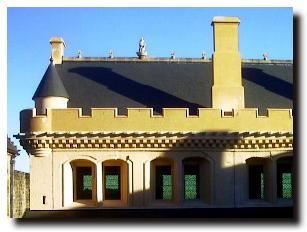 The castle was the backdrop to the murder of William, 8th Earl of Douglas by King James II. The castle was greatly expanded by Kings James IV and V - it is James V we have to thank for the Great Hall which has recently been restored to its former glory and for the building known as the Palace.
The castle was the backdrop to the murder of William, 8th Earl of Douglas by King James II. The castle was greatly expanded by Kings James IV and V - it is James V we have to thank for the Great Hall which has recently been restored to its former glory and for the building known as the Palace.
The renovation of the Great Hall has returned it to its original colour - an arresting yellow, described by restorers as "King's Gold". The new harling and limewash was determined by careful research and it is how that part of the castle would have appeared in the 16th century when it was built by James IV. The renovation work is part of a 20 million pound project at the castle.
Mary Queen of Scots was crowned in Stirling Castle in 1543 and her son, James VI was christened in the nearby parish church. James VI spent a lot of time at Stirling Castle and his first son, Prince Henry, was born there. But after the Union of the Crowns in 1603, the next royal visit was by King Charles II in 1650.
The need for a fortified castle receded and the castle deteriorated. It was only in 1906 (after the personal intervention of Edward VII) that it was brought back to a proper state of repair. It was used as an army barracks until 1964 (remember the film "Tunes of Glory" shot at Stirling?).
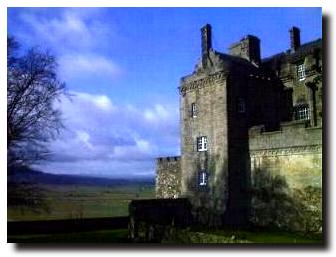 This shot, showing a corner of the Palace, also looks over the flat alluvial plain of the valley of the river Forth. The classical facades were the result of the influence of French masons
This shot, showing a corner of the Palace, also looks over the flat alluvial plain of the valley of the river Forth. The classical facades were the result of the influence of French masons
Now owned by Historic Scotland, Stirling is second only to Edinburgh Castle in the number of visitors each year. There is a lot to see in the castle and there is a good visitor centre and restaurant.
 The entrance to the castle is on the from the south-east, where the alluvial tail left after the ice age, had left a more gradual approach to the rock. From the outer defences in front of the castle, the "forework", this entrance passes through to the "Outer Close". The building at the far end at one time formed the kitchens for the garrison - and now part of it houses the visitors' restaurant.
The entrance to the castle is on the from the south-east, where the alluvial tail left after the ice age, had left a more gradual approach to the rock. From the outer defences in front of the castle, the "forework", this entrance passes through to the "Outer Close". The building at the far end at one time formed the kitchens for the garrison - and now part of it houses the visitors' restaurant.
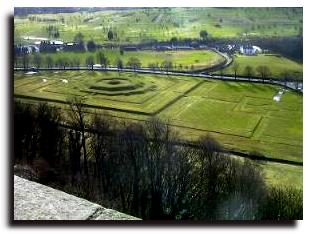 Beneath the castle and the Queen's Hole, an area for the ladies to sit out and enjoy the view, is the "King's Knot", which was a grand formal garden. Only the outline of the King's Knot and an adjoining parterre (an area of flower beds and pathways) remain. In the afternoon and evening the area would enjoy the sunshine.
Beneath the castle and the Queen's Hole, an area for the ladies to sit out and enjoy the view, is the "King's Knot", which was a grand formal garden. Only the outline of the King's Knot and an adjoining parterre (an area of flower beds and pathways) remain. In the afternoon and evening the area would enjoy the sunshine.
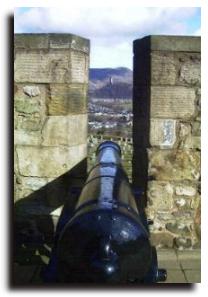 On the other side of the castle is the "Grand Battery" with around half-a-dozen cannon (with accompanying cannon balls - carefully contained in a cage in case a tourist decides they want a souvenir). The cannon face to the north, across the River Forth at Stirling Bridge, towards the Wallace National Monument on Abbey Craig, in the distance.
On the other side of the castle is the "Grand Battery" with around half-a-dozen cannon (with accompanying cannon balls - carefully contained in a cage in case a tourist decides they want a souvenir). The cannon face to the north, across the River Forth at Stirling Bridge, towards the Wallace National Monument on Abbey Craig, in the distance.



